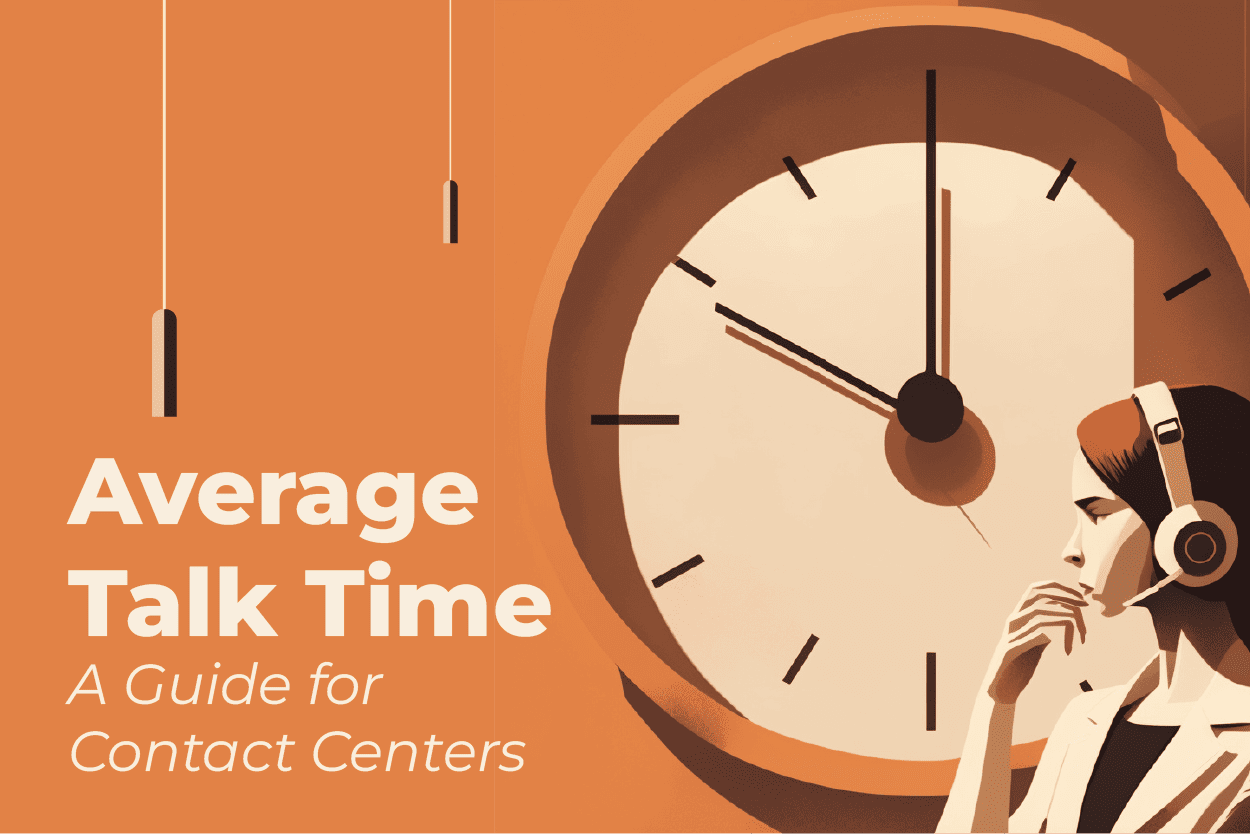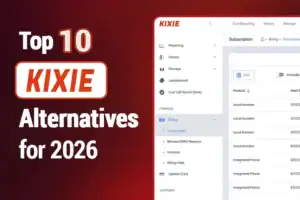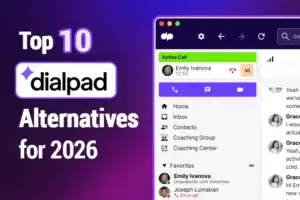For call centers, metrics provide insights that shape strategies and determine operational efficiency. Among these metrics, the “Talk” metric stands out as a vital instrument. It delves into agent-customer interactions, revealing both the quantity and quality of these engagements.
Understanding the Average Talk Time metric
 Average Talk Time represents the actual duration an agent spends talking with a customer. Unlike “Hold”, “Wait”, or “Average Handle – AHT” times, this metric concentrates solely on the productive interaction between the two parties.
Average Talk Time represents the actual duration an agent spends talking with a customer. Unlike “Hold”, “Wait”, or “Average Handle – AHT” times, this metric concentrates solely on the productive interaction between the two parties.
In essence, it reflects operational efficiency and agent performance. A lower ATT typically indicates quicker issue resolution and streamlined customer service. However, excessively low ATTs can be problematic, potentially suggesting agents are rushing through calls, sacrificing quality for speed.
On the flip side, high ATTs may point to prolonged conversations, which can be indicative of inefficiencies, complex inquiries, or inadequate agent training. To optimize ATT, call centers employ various strategies, such as agent training programs, call scripting, and technological tools, to strike the right balance between service quality and efficiency.
ATT sheds light on:
- Agent Efficiency: ATT serves as a litmus test for agent effectiveness. A lower ATT implies agents can efficiently handle customer concerns, demonstrating their ability to navigate inquiries swiftly while maintaining service quality.
- Operational Flow: ATT also offers insights into the operational flow. If ATT is consistently high, it may signal that agents lack the requisite information or tools needed for speedy issue resolution, highlighting potential process bottlenecks and training needs.
- Customer Satisfaction: Longer talk times, indicated by a high ATT, can hint at potential issues in service delivery or product comprehension. It may suggest that customers are struggling to get the information they need or that agents are encountering difficulty in fully addressing customer inquiries, which can impact overall customer satisfaction.
The Importance of “Talk” Metric Analysis
Effective analysis of the “Talk” metric offers a multitude of benefits for call centers. By assessing “Talk” times, call centers can identify training needs or knowledge gaps. Shortened, more efficient conversations often lead to increased customer satisfaction as queries are resolved speedily. Moreover, monitoring this metric helps in determining the workload and evenly distributing it among available agents, ensuring every customer receives undivided attention and preventing burnout.
But that’s not all. Through the study of patterns in “Talk” times, predictive analysis can be employed to make informed decisions about future call durations and required resources, ultimately leading to better scheduling and resource planning.
- Enhanced Customer Service
By assessing “Talk” times, call centers can identify training needs or knowledge gaps. Shortened, more efficient conversations often lead to increased customer satisfaction as queries are resolved speedily.
- Efficient Resource Allocation
Monitoring this metric helps in determining the workload and evenly distributing it among available agents. Proper allocation prevents burnout and ensures every customer receives undivided attention.
- Predictive Analysis
By studying patterns in “Talk” times, predictions can be made about future call durations and required resources. This proactivity can lead to better scheduling and resource planning.
In the contact center realm, measuring Talk Time isn’t just about numbers; it’s the compass guiding us toward efficiency, quality, and customer satisfaction. It’s the pulse of productive conversations, where every second counts in delivering exceptional service. – Brad Butler, Contact Center Software Consultant @NobelBiz
How is Talk Time Measured?
Measuring Talk Time is like clocking the duration of a 100m dash – it seems straightforward, but there’s more to it than meets the eye. For reference, according to callcenterhelper.com, the industry standard for Average Handling Time (AHT) is 6 minutes and 10 seconds. To calculate the average talk time, you can use the formula: Average talk time = (Total customer handling time – hold time – wrap-up time)/total calls handled.
Components of Talk Time
Talk Time encompasses several sub-metrics, including:
- Active Speaking Time: This measures the actual duration an agent spends actively speaking during a call. It’s a crucial component as it reflects how efficiently agents convey information and address customer inquiries.
- Listening Time: Listening is a significant part of effective communication. This metric tracks the time agents spend actively listening to the customer, ensuring they comprehend the customer’s needs and concerns.
- Silent Pauses: Silent pauses are the gaps in conversation where the agent may be accessing information or processing the conversation. These pauses provide valuable insights into agent behavior and can help identify areas where training or access to information may need improvement. Monitoring and optimizing these components collectively contribute to achieving efficient and effective Talk Time management in call centers.
Methods to Measure the ATT
 Advanced software solutions, sometimes integrated into the CRM, track Talk Time. They automatically start the timer when the agent begins speaking and pause during hold times.
Advanced software solutions, sometimes integrated into the CRM, track Talk Time. They automatically start the timer when the agent begins speaking and pause during hold times.
CCaaS software solutions like NobelBiz OMNI+ integrate seamlessly into CRM systems to monitor ATT efficiently. OMNI+ automatically starts the timer when agents begin speaking and intelligently pauses it during hold times, ensuring precise measurements. Beyond ATT, OMNI+ offers comprehensive tools for resource allocation, predictive analysis, and quality management, making it the go-to solution for enhancing contact center efficiency and customer experiences.
Pros and Cons of Using Talk Time Metric
Like any tool in the shed, Talk Time has its strengths and limitations.
In a sense, Talk Time is a double-edged sword – a powerful tool with its own set of intricacies. It’s a compass for efficiency, shedding light on agent performance and training needs while offering glimpses into customer satisfaction. Yet, it’s not the sole measure of quality, and its overemphasis can inadvertently strain agents and compromise the customer experience. The wisdom lies in balancing its insights with a holistic view of call center dynamics. – Christian Montes, Executive Vice President Client Operations @NobelBiz
Advantages
- Efficiency Monitoring: Helps identify agents who might be spending too much or too little time on calls.
- Training Opportunities: Can highlight areas where agents might need further training or support.
- Customer Satisfaction Insights: Extremely long or short calls might indicate customer frustration or issues not being resolved.
Disadvantages
- Not Always Indicative of Quality: A short call isn’t always a good call, and a long call isn’t always a bad one.
- Pressure on Agents: Overemphasis can pressure agents to rush calls, potentially harming customer experience.
Optimizing “Talk” Time: Best Practices
 In the realm of customer service efficiency, mastering “Talk” Time is essential. By incorporating these best practices, you can empower your agents with the right tools, knowledge, and feedback mechanisms to ensure efficient customer interactions.
In the realm of customer service efficiency, mastering “Talk” Time is essential. By incorporating these best practices, you can empower your agents with the right tools, knowledge, and feedback mechanisms to ensure efficient customer interactions.
Continuous Training
Providing ongoing training to your agents is fundamental. Equip them with the latest product knowledge to ensure they can answer customer queries accurately. Bolster their communication skills to enhance their ability to convey information clearly and concisely. Moreover, staying up-to-date with technological advancements is vital, enabling your agents to leverage the latest tools and systems for more efficient customer interactions.
Access to Information
Swift access to essential data is a game-changer. The faster your agents can retrieve relevant information, the more effectively they can assist customers. Implement a streamlined information retrieval system, whether it’s through a comprehensive knowledge base or well-organized databases. This not only reduces customer wait times but also enhances the quality of service as agents can provide accurate and timely responses.
Feedback Loop
Creating a feedback loop is integral to agent improvement. Establish a system where agents regularly receive constructive feedback on their performance. This feedback loop not only helps identify areas in need of improvement but also allows for commendation when agents excel. It boosts agent morale, fosters a culture of continuous improvement, and ultimately contributes to a higher level of customer service excellence.
 If you want to go beyond the Average Talk Time sales success, explore our on-demand webinar: “Boosting Outbound Sales Performance.” If your business thrives on telemarketing, lead gen, or debt collection, this is a must-watch. Dive into the world of outbound sales, from industry insights to performance optimization. Learn how Contact Center data and technology can elevate your sales game. Access it now for valuable insights from experts Kevin Daly and Mike McGuire. Don’t miss out—watch today!
If you want to go beyond the Average Talk Time sales success, explore our on-demand webinar: “Boosting Outbound Sales Performance.” If your business thrives on telemarketing, lead gen, or debt collection, this is a must-watch. Dive into the world of outbound sales, from industry insights to performance optimization. Learn how Contact Center data and technology can elevate your sales game. Access it now for valuable insights from experts Kevin Daly and Mike McGuire. Don’t miss out—watch today!
Real-world Applications
You might be wondering if all these strategies are just theoretical. Well, they’re not! They are real-world practices that companies have implemented to enhance their customer service operations significantly.
Success Stories
Numerous organizations have achieved remarkable results by reducing their average Talk Time through focused training and the adoption of cutting-edge tools. This not only streamlined their customer interactions but also contributed to improved customer satisfaction levels and operational efficiency. These success stories demonstrate the tangible benefits of optimizing Talk Time in the contact center.
Lessons from Failures
Conversely, companies that overlooked the importance of managing Talk Time often faced detrimental consequences. Lengthy queues, frustrated customers, and overburdened agents became common issues. These failures underscore the critical role that Talk Time plays in maintaining a smooth, efficient, and customer-centric contact center environment. It’s a valuable lesson for organizations looking to avoid the pitfalls of neglecting this essential metric.
Conclusion
The Average Talk Time metric is not just a numerical value; it’s an insight into the operational efficiency of a call center. It reflects the agent’s capabilities, the system’s robustness, and the overall satisfaction of the end customer. By focusing on optimizing this metric, call centers can significantly enhance their service delivery and ensure they remain ahead in a competitive landscape.
When it comes to optimizing your contact center’s Average Talk Time (ATT), choosing the right carrier provider can make all the difference. NobelBiz stands out as a prime choice for contact centers aiming to excel in this aspect.
Our NobelBiz Voice Carrier Network is purpose-built for the contact center industry, offering unparalleled services, coverage, and pricing. We provide a versatile array of smart tools designed to enhance contact rates, boost productivity, and ensure compliance. With NobelBiz, you not only streamline your operations but also gain access to telecom services trusted by some of the largest contact centers in the industry. Elevate your Average Talk Time and overall customer service experience with NobelBiz as your carrier provider.

Michael McGuire is a contact center industry expert with almost two decades of experience in the space. His experience includes roles as Director of Contact Center Digital Transformation at NobelBiz, and as Director of Operations at FLS Connect, managing multiple call centers. As President of Anomaly Squared and Targeted Metrics, Michael successfully transitioned companies into remote operations and significantly boosted revenues. With a strong background in customer service, leadership, strategic planning, and operations management, Michael excels in driving growth and innovation in the call center space.
Mike is also a proud Board Member for R.E.A.C.H Trade Group, promoting consumer protection and satisfaction and Co-host of the Off Skripted Podcast – a show about Life, Call Centers and everything in between.






